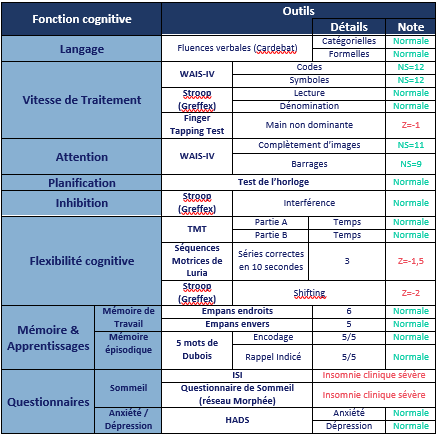Clinical Case : Mrs. S, 56 years old
Context : Mrs. S, 56, tested positive for COVID-19 in the spring of 2021, with central and peripheral neurological symptoms, and muscle symptoms (to learn more about these symptoms, feel free to consult the great article that we wrote HERE). 3 months later, Mrs S still presents a strong attentional, memory and language complaint and has not been able to resume her professional activity. Mrs. S also has a history of sleep disorders, amplified since COVID.
Traditional events :
Among the tests classically used in neuropsychological screening, Mrs S presents average performance for the vast majority of them. Only the flexibility appears to be significantly impacted through a slowdown in the Interference part of the Stroop as well as in the Luria sequences. A slight motor slowdown is also found in the non-dominant hand, but remains insignificant although it perfectly illustrates the patient's complaint.

MindPulse The MindPulse highlights an executive and attentional imbalance, with a very strong slowdown in perceptual-motor speed, coupled with a significant executive slowdown. On the other hand, the patient presents satisfactory precision, as well as reaction to the adapted difficulty.


The detailed analysis of the MindPulse highlights the high variability of the response times of Mrs. S, which presents a very significant dispersion, from the first part of the MindPulse. Coupled with this extreme variability, the presence of aberrant responses, or attentional eclipses, indicates an impairment of vigilance and executive attentional control. Mrs. S. is unable to mobilize her attention effectively: her sustained attention appears to be deficient, with extremely significant effects of fatigue that are found through the variability of response times and executive and perceptual-motor slowing.

Conclusion : Despite a normal neuropsychological screening, with the exception of certain measures of cognitive flexibility which highlight a moderate slowdown in Mrs S, the use of more sensitive tools such as the MindPulse makes it possible to highlight a very significant attentional and executive imbalance , marked in the foreground by an executive and perceptual-motor slowdown in Mrs. S. This profile suggests a subcortico-frontal attack and is accentuated by the aggravation of the patient's sleep disorders, which strongly contributes to impairment of attentional and executive functions, in particular alertness and attentional control.
This case highlights the importance of adding a systematic assessment of sleep disorders in neuropsychological assessments following COVID-19 and the need to add sensitivity tools to them. Indeed, like Mrs S, the majority of post-COVID-19 patients presenting with a cognitive complaint are often young and the screening tools conventionally used prove to be ineffective in highlighting the mild to moderate alterations found in these populations. However, the difficulties are well existing and need to be objectified and effectively taken note of in order to optimize the adaptive prognosis of these patients whose profile is still poorly understood.
